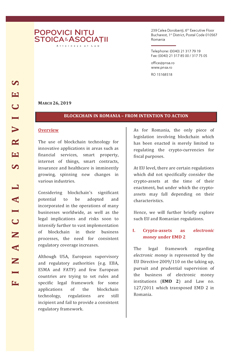- About Us
-
Expertise
- Banking & Finance
- Capital Markets
- Competition & Antitrust
- Corporate & Commercial
- Data Privacy
- Employment & Pensions
- Energy & Natural Resources
- Gambling & Betting
- Healthcare & Pharmaceuticals
- Insurance
- Intellectual Property
- International Arbitration
- Litigation
- Mergers & Acquisitions
- Project Finance/PPP, Concessions & Infrastructure
- Public Procurement
- Real Estate
- Restructuring & Insolvency
- Sports Law
- Tax
- Telecommunications, Media & Technology
- Transports & Logistics
- White Collar Compliance & Defense
- Our team
- Careers
- Publications
- News and Press
- Contact
Legal Update
Blockchain in Romania – From Intention to Action
FINANCIAL SERVICES

Alexandru Ambrozie - Partner, PNSA
Overview
The use of blockchain technology for innovative applications in areas such as financial services, smart property, internet of things, smart contracts, insurance and healthcare is imminently growing, spinning new changes in various industries.
Considering blockchain’s significant potential to be adopted and incorporated in the operations of many businesses worldwide, as well as the legal implications and risks soon to intensify further to vast implementation of blockchain in their business processes, the need for consistent regulatory coverage increases.

Codrin Luță - Managing Associate, PNSA
Although USA, European supervisory and regulatory authorities (e.g. EBA, ESMA and FATF) and few European countries are trying to set rules and specific legal framework for some applications of the blockchain technology, regulations are still incipient and fail to provide a consistent regulatory framework.
As for Romania, the only piece of legislation involving blockchain which has been enacted is merely limited to regulating the crypto-currencies for fiscal purposes.
At EU level, there are certain regulations which did not specifically consider the crypto-assets at the time of their enactment, but under which the crypto-assets may fall depending on their characteristics.

Diana Dobra - Associate, PNSA
Hence, we will further briefly explore such EU and Romanian regulations.
I. Crypto-assets as electronic money under EMD 2
The legal framework regarding electronic money is represented by the EU Directive 2009/110 on the taking up, pursuit and prudential supervision of the business of electronic money institutions (EMD 2) and Law no. 127/2011 which transposed EMD 2 in Romania.
A crypto-asset would qualify as electronic money under the provisions of EMD 2 and Law no. 127/2011 if it cumulatively satisfies the following:
- is electronically (including magnetically) stored;
- has monetary value;
- represents a claim on the issuer;
- is issued on receipt of funds;
- is issued for the purpose of making payment transactions;
- is accepted by persons other than the issuer.
In case of those crypto-assets that cumulatively meet these requirements, the issuer should consider the authorisation as an electronic money issuer.
II. Crypto-assets as funds under PSD 2
The EU Directive 2015/2366 on payment services in the internal market (PSD 2) regulates the activity of payment service providers and payment institutions.
A crypto-asset would fall under the scope of PSD 2, if it qualifies as:
- banknotes or coins;
- scriptural money; or
- electronic money, as defined by EMD 2.
As the crypto-assets do not fall within the definition of funds as they are neither banknotes/coins, nor scriptural money, PSD 2 is applicable only to crypto-assets which qualify as electronic money under EMD 2.
Hence, in case a company performs/wishes to perform the activities regulated by PSD 2 by using crypto-assets that qualify as electronic money, such activity will fall within the scope of PSD 2, resulting in the obligation of the company to register with the relevant authorities and to respect the prudential requirements set out in the PSD 2.
We note that Romania has not yet transposed PSD 2. There is only a proposed draft of law in public debate from as early as May 2018.
Although Romania has implemented only PSD 1, since the definition of funds has not been changed from PSD 1 to PSD 2, the analysis on the qualification of crypto-assets as funds is relevant for Romania too.
III. Crypto assets as financial instruments under MiFID II
In its recent Advice on Initial Coin Offerings and Crypto-Assets issued in January 2019, ESMA pointed out that there is a wide variety of crypto-assets, such as: (i) investment-type, (ii) utility-type, (iii) hybrids of investment-type and utility-type, and (iv) payment-type.
According to ESMA, payment-type crypto-assets are unlikely to qualify as financial instruments under EU Directive 2014/65 (MIFID II) since “they have no tangible value, except for the expectation they may serve as a means of exchange or payment to pay for goods or services that are external to the ecosystem in which they are built”.
While the approach of the authorities and the definitions of financial instruments are not consistent among member states, ESMA concluded that the majority would consider as financial instruments the crypto-assets having profit, ownership or governance rights attached.
These considerations are also applicable to Romania, as Law no. 126/2018 on markets in financial instruments transposes MIFID II with fidelity.
The crypto-assets should be considered on a case-by-case basis, depending on their characteristics. In case the financial instrument test in MiFID II is met, the other EU financial regulations will apply such as: the Prospectus Regulation, the Transparency Directive, MAR, the Settlement Finality Directive, the Central Securities Depositories Regulation, AIFMD.
IV. Crypto-assets under AMLD 5
At present, the only definition of crypto-assets is offered by the EU Directive 2018/843 on the prevention of the use of the financial system for the purposes of money laundering or terrorist financing (“AMLD 5”), which defines the virtual currencies as “a digital representation of value that is not issued or guaranteed by a central bank or a public authority, is not necessarily attached to a legally established currency and does not possess a legal status of currency or money, but is accepted by natural or legal persons as a means of exchange and which can be transferred, stored and traded electronically”.
AMLD 5 defines the virtual currencies and custodian wallet providers for AML purposes, requiring crypto-asset exchanges and custodian wallet providers in the EU to carry out customer identification and to exercise due diligence.
Considering that Romania has not taken any steps into implementing AMLD 5 and it is now striving to transpose AMLD 4, without reference to virtual currencies, crypto-asset exchanges and custodian wallet providers operating in Romania do not have these obligations.
Conclusions and recommendations
As many of the crypto-assets seem to fall outside the scope of the EU financial service provisions and the corresponding Romanian regulations, their use may generate potential risks referring to consumer protection, operational resilience, market integrity, cyber security and information security.
Although attempting to extend the applicability of the existing legal framework to crypto-assets does not seem the best approach as it generates uncertainty and risks for clients and businesses, the issuers should be aware that, until specific legislation is approached, the relevant authorities tend to extend the existing legal framework so as to apply to crypto-assets too. As such, the issuers should carefully assess the characteristics of their crypto-asset and the necessity for further authorisations.
Legal certainty and safety require consistent legal framework regulating the crypto-assets. The sooner, the better, as the applications of crypto-assets are increasing at a fast pace.
This document is intended for informational purposes only, does not represent legal advice and does not focus on particular cases.
For further information or analysis on specific matters, please contact Alexandru Ambrozie or Diana Dobra.
Download Document











